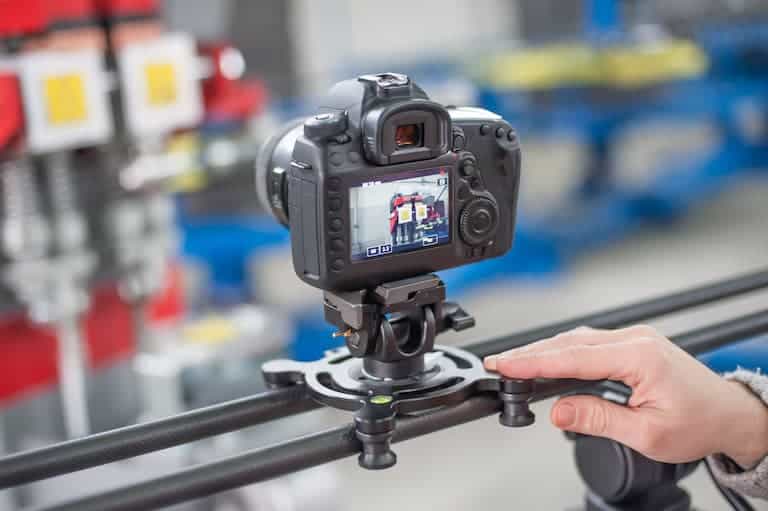Getting the right shot can make or break a video project. While angles and lighting are extremely important, so is being able to get the right moving video as well. Sliders and gimbals are both tools used to record motion in videos, but they function differently.
A camera slider is better for jobs that need a smoothly moving video shot. On the other hand, gimbals allow for more stable shots compared to when holding a camera, as they have more room for shaky images. Both recording tools come with their pros and cons.
Keep reading if you’re trying to decide between a camera slider and a gimbal for your next filming project. We’ll explain the key differences between these two filming tools and when you should choose one over the other.
Table of Contents
What Is a Camera Slider?
A camera slider, sometimes called a dolly slider (if a dolly system is attached to a track), is a tool used to film motion shots smoothly and stably. Camera sliders allow you to move the camera smoothly when taking horizontal shots.
They are typically made of a track, a tripod that will slide along that track, and a camera mount for the camera person to control the angle and movement of the camera.
Sliders are an essential part of filmmaking because heavy camera equipment is often used, which is more difficult to keep steady if the camera is supposed to move during filming.
If you’ve ever watched a movie where the camera appears to follow what is happening on screen in a smooth way, then a camera slider was likely used when recording that scene.
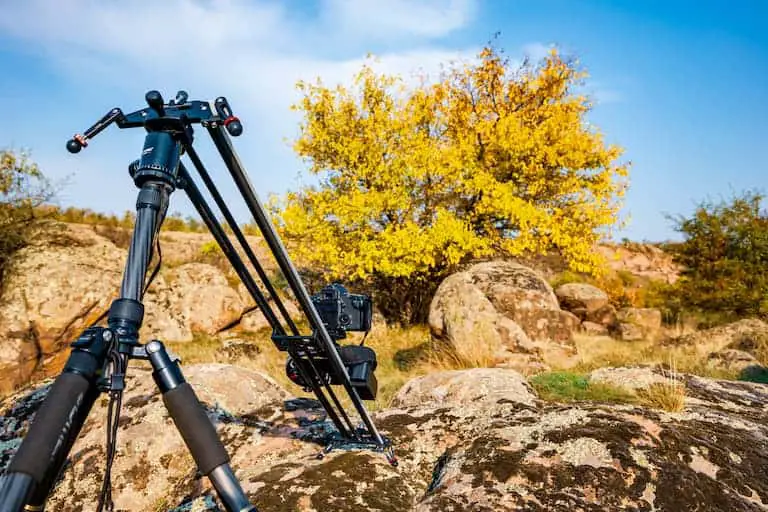
When Do You Use It?
Camera sliders can be used for any type of filming since their track doesn’t have to be used.
However, in most cases, camera sliders are only used in specific filming circumstances when they can add something to the shot that would otherwise be missing.
Camera sliders are used to film moving scenes that require the camera to record smoothly from left to right, forward to back, or vice-versa. In some cases, sliding rigs can even be assembled to take smooth, vertical shots when a wire rig wouldn’t be necessary.
The main thing to remember is that sliders are used to capture movement with more depth than a still camera would.
It allows the viewer to feel like they’re in the scene due to the moving effect created by the slider.
Instead, a still camera can only capture movement from a stationary point, meaning it creates more of a passive viewing experience.
Sliders can help introduce locations that are being revealed to the characters for the first time. By using a slider in this context, the viewer will feel as if they’re discovering the new setting together with the characters, which helps personalize scenes and make them more relatable.
Sliders are also used to capture movement when the shot follows a moving character you’re supposed to keep up with.
If you’re using a slider to film a running character, you can keep pace with them in a stable way that you can’t accomplish by holding the camera any other way.
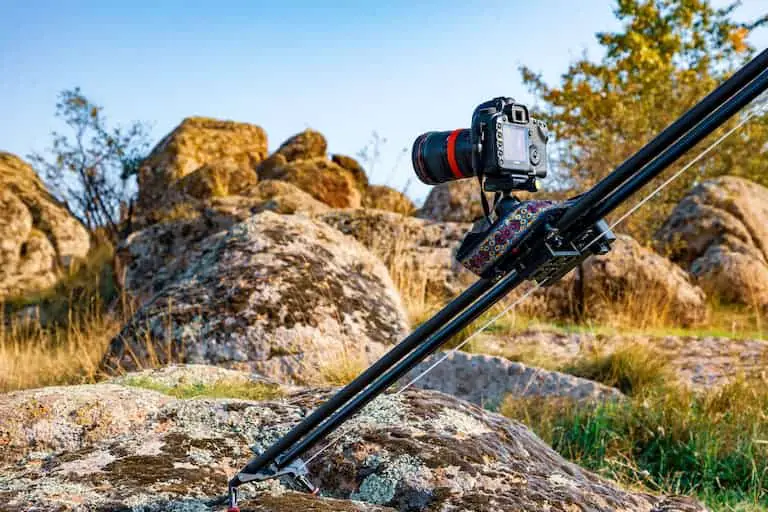
What Is a Gimbal?
Gimbals are a slightly newer accessory in the camera and filming world. However, they’ve been used in some form for years, even before they had a name.
A camera gimbal is a sort of portable tripod and grip that allows a camera operator to move with the camera without having to rest it on their shoulder. Unlike traditional tripods, gimbals have image-stabilization technology to keep shots from being too shaky.
Gimbals can come in different forms, from handheld models that look like selfie-sticks to full rigs that the cameraman wears in order to operate them.
The type of model used on a job will depend on the camera’s size and the sort of filming being done.
Unlike other image stabilizing tools used in filmmaking, gimbals are usually smaller and less complicated to assemble, so they can be used quickly or on shorter notice.
These features also make them less expensive than other stabilizers like dollies or sliders, which makes them affordable and ideal for personal filming projects.
In fact, gimbals have built-in motion detectors to help keep the image stable.
That means that, while professional filmmakers will often use gimbals for certain types of scenes, they also allow a certain amount of “hands-off” filming, making them ideal for amateur filmmakers.
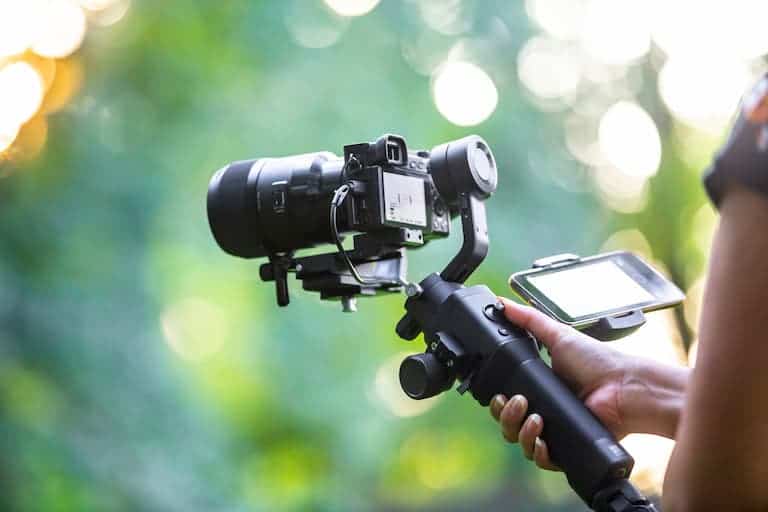
When Do You Use It?
Gimbal rigs, like camera sliders, can be used for any type of filming. In fact, a scene that transitions from still to moving could be entirely shot with a camera in a gimbal rig in some situations.
And although you can technically use a gimbal system for any sort of filming, the tool was actually designed with a specific purpose in mind.
Gimbals are used to film different types of movement. They can track a character or object as they move through a set, they can be used to swivel perspectives, or they can be used to establish settings in different ways that a standard static camera on a tripod can’t.
That description might sound similar to other filmmaking tools used to capture movement. However, Gimbals are their own specific type of tool.
For example, if you want a movement shot that follows a person running but you want the scene to feel more natural, you might use a gimbal.
That’s because a gimbal will stabilize any shaking that makes the video difficult to watch but will still move with the camera operator.
So, if the cameraman is running, the up and down motion caused by a running effect will still be captured, only without any excess instability.
This is useful if the goal of your filming is to not only make the viewer feel like they’re playing a more active role in watching your video but that they’re actually in the scene and moving as the characters are.
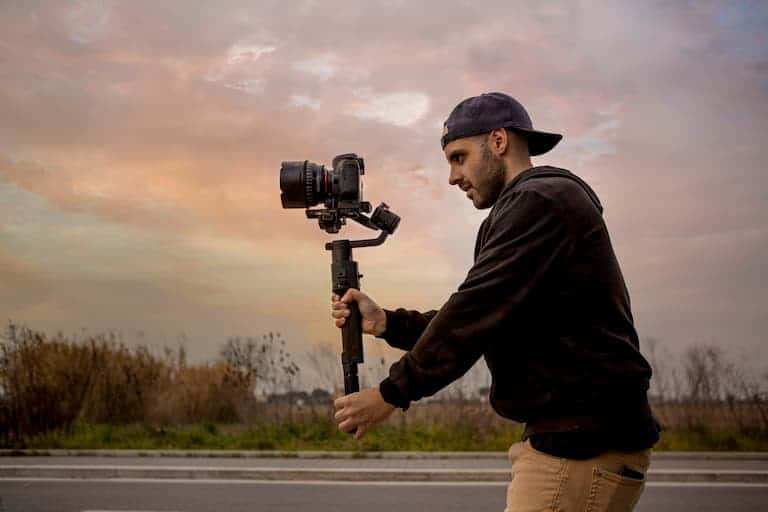
How Are Camera Sliders and Gimbals Similar?
Sliders and gimbals can sometimes be confused for one another. Though they look very different, these two filming tools do have some similarities.
The most obvious similarity between a camera slider and a gimbal is what they’re primarily used for.
Both of these tools are intended to capture motion and movement. They both also do this in a way that is more stable than simply holding and walking with a camera, thereby improving overall footage quality.
Since these tools are primarily used to film moving shots, they also allow more depth in the filming process.
The viewer isn’t just watching events unfold passively; they’re actually moving through a scene.
Both of these tools, for example, are used when filming virtual tours or locations because they allow the viewer to feel like they’re actually moving through the settings.
Additionally, both tools are also used to establish scenes in-depth despite doing so in different methods.
It’s also worth noting that these tools are used for tracking purposes, more specifically when the camera is following something specific on-screen.
Both of these tools have also made filming moving scenes easier.
Before their invention, camera operators were forced to carry their cameras or develop a less reliable rig if a scene required any camera movement.
Not only was this difficult from an image-stabilizing point of view, but it was also physically taxing.
And although modern professional cameras are compact and relatively lighter, previous models were quite heavy. As a result, motion shots took longer to film because operators would easily get tired from holding, steadying, and moving with cameras.
Sliders and gimbals made this process easier by allowing a camera’s weight to be supported differently, without affecting the quality of recordings.
The Biggest Differences Between Camera Sliders and Gimbals
There are considerable differences between sliders and gimbals that make them distinct tools in the filmmaking world.
How They’re Built
The biggest difference to address between them is the way they’re both constructed.
Camera sliders are tracks that a camera slides on. While this sliding is controlled by a camera operator (both in speed and distance), the system itself is completely separate, which means an operator isn’t holding the camera at all.
A gimbal, instead, is held or worn by the camera person on a film set. This means that, while a gimbal will distribute a heavy camera’s weight by using a support rig system, the camera operator is still in full control of the camera.
The Movement They Capture
Another big difference between these two tools is the type of movement they capture.
As we’ve mentioned already, camera sliders allow for a smooth, continuous movement shot. Since the camera is being held by the slider itself, you don’t have to worry about it being unsteady as long as the slider is assembled correctly and the camera is correctly mounted.
On the other hand, gimbals have stabilizing technology but won’t capture the same fluid camera motion a slider will because humans don’t walk as smoothly as something that glides on a track.
That means that there will always be a more raw and slightly less stable quality to videos filmed using gimbals. This is often the intention when this particular tool is used.
Filming Freedom
The amount of freedom you have as a filmmaker is also slightly different when you use a slider versus a gimbal.
Sliders operate on a straight track. That means they have one direction they can move back and forth on, so they’re constrained to filming a straight line of movement.
Gimbals, on the other hand, have more freedom in terms of motion as they’re not limited by a track. As long as the camera person can move, the gimbal can move.
That means filming with a gimbal allows filmmakers to capture movement that goes in a circle or changes direction. It can even track an object that suddenly begins moving in a vertical direction after having moved horizontally for a while and vice-versa unlike a camera slider.
Camera Settings and Operations
Finally, the way a camera can be operated is different when using a slider and a gimbal.
When using a slider, if the camera is still, its operator can freely adjust any settings the way they would if the camera were static. That means that the camera operation is just as hands-on as it would be if it were on a tripod.
On the other hand, adjusting settings when using gimbals can prove taxing, if not impossible.
Since some gimbals are actually worn by camera operators, it can be difficult to access the camera while it’s mounted.
That means changing any settings on the camera while it’s being used can be difficult.
Due to this, it is highly advisable to adjust all your settings before mounting your camera on a rig when filming with a gimbal. This eliminates the need for adjustments when filming using gimbals.
While recording with a gimbal makes filming easier in many ways, you won’t be able to make adjustments or change your settings. The good news, however, is that gimbals allow for more hands-off filming since the operator doesn’t have to worry much about the camera’s settings.
Can You Use Camera Sliders and Gimbals Interchangeably?
While there are some clear differences between these two pieces of filming equipment, you might still wonder if you can substitute a slider for a gimbal when filming.
In most cases, you cannot use camera sliders and gimbals interchangeably. However, in cases when a filmmaker just wants to film movement but has no other visions for their work, they may not care which of these two tools is used.
Most of the time, a filmmaker will want to evoke a particular emotion or accomplish specific goals through their filming. Thus, one of these two options will usually be more appropriate than the other.
For example, a smooth establishing shot of a scene will likely call for a slider, while a scene following a person running across a floor and up steps might need a gimbal.
Conclusion
Ultimately, if you’re torn between a camera slider and a gimbal for a job, you’ll need to figure out what you want to accomplish with your filming.
If you want smooth scenes that will mostly be filmed in a straight line, and you want to be able to adjust your camera continuously, a slider is a right choice.
But if you want more freedom to move around and more organic footage, you might want to opt for a gimbal.

